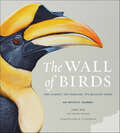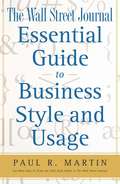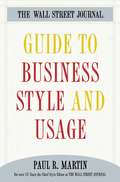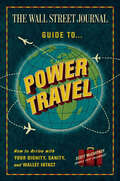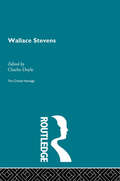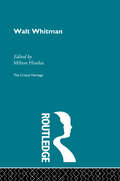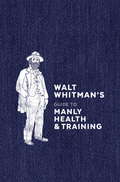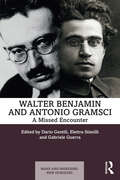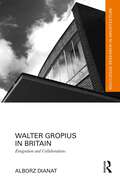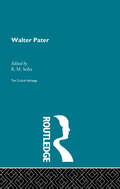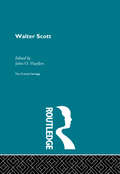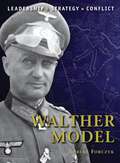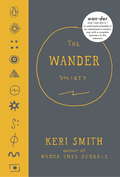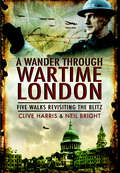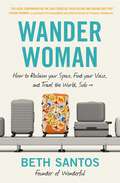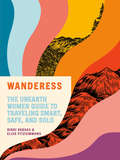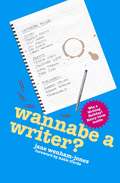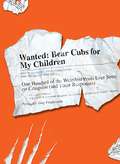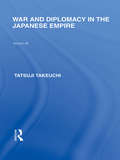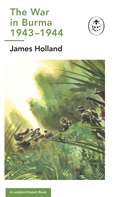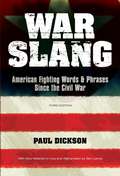- Table View
- List View
The Wall of Birds: One Planet, 243 Families, 375 Million Years
by Jane Kim Thayer WalkerA celebration of the diversity and evolution of birds, as depicted in the Cornell Lab of Ornithology's magnificent 2,500-square-foot Wall of Birds mural by artist Jane Kim.Part homage, part artistic and sociological journey, The Wall of Birds tells the story of birds' remarkable 375-million-year evolution. With a foreword by John W. Fitzpatrick, director of the Cornell Lab of Ornithology, and full of lush photographs of gorgeous life-size birds painted in exacting detail, The Wall of Birds lets readers explore these amazing creatures family by family and continent by continent. Throughout, beautifully crafted narratives and intimate artistic reflections tell of the evolutionary forces that created birds' dazzling variety of forms and colors, and reveal powerful lessons about birds that are surprisingly relevant to contemporary human challenges.From the tiny five-inch Marvelous Spatuletail hummingbird to the monstrous thirty-foot Yutyrannus, The Wall of Birds is a visual feast, essential for bird enthusiasts, naturalists, and art lovers alike.
The Wall Street Journal Essential Guide to Business St
by Paul MartinThe indispensable resource that has helped the writers and editors of The Wall Street Journal earn a reputation for the most authoritative business writing anywhere -- now fully expanded and revised for the twenty-first century In the field of business, the words you use -- and how you use them -- can either bolster your credibility or undermine your intelligence. For anyone who is faced with the task of writing a memo, report, proposal, press release or even an e-mail, The Wall Street Journal Essential Guide to Business Style and Usage is an invaluable one-stop resource. Originally intended exclusively for use by the paper's staff, the book is organized in a user-friendly A to Z format, with appropriate cross-referencing, that helps you solve almost any question of spelling, grammar, punctuation or word definition. For those seeking a competitive edge for succeeding in the world of business, The Wall Street Journal Essential Guide to Business Style and Usage is the definitive reference to keep close to your desk -- the last word for everyone who works with words.
The Wall Street Journal Guide to Business Style and Us
by Paul MartinHere at last is the indispensable resource that has helped the writers and editors of The Wall Street Journal earn a reputation for the most authoritative business writing anywhere. Originally written exclusively for the paper's staff, The Wall Street Journal Guide to Business Style and Usage is a landmark work. Many years in preparation, it has now been expanded and revised for anyone who wants to write well, but especially for those in the business community. The only book of its kind, it offers A-Z guidance on style and usage, bearing in mind the special needs of business professionals and including the latest business terminology. If ABC is no longer the American Broadcasting Company, what is it? What is the difference bet-ween "adjusted gross receipts" and "adjusted gross income"? How about the differences among "adopt," "approve," "enact" and "pass"? When should you say "affect" and when "effect"? When did Generation X end and Generation Y begin? And what the heck is the new name of Andersen Consulting? Our language is ever changing, ever mutating, and the choice of the right word bolsters your credibility with readers. As the go-to resource for these questions and others, The Wall Street Journal Guide to Business Style and Usage gives readers a competitive edge for succeeding in the world of business. It is an invaluable resource for any member of the business community who has ever had to write a memo, report, proposal, press release or e-mail. Destined to be the standard resource for years to come, The Wall Street Journal Guide to Business Style and Usage provides readers with access to the Journal Web site (www.wsjbooks.com), which will feature updates as new business terms enter the language or as old definitions or usages give way to new. This guide is the definitive reference work to keep close to your desk -- the last word for everyone who works with words.
The Wall Street Journal Guide to Power Travel: How to Arrive with Your Dignity, Sanity, and Wallet Intact
by Scott McCartneyImagine a world without late planes, missed connections, lost luggage, bumped passengers, cramped seating, high fees and higher fares, surly employees, and security lines. . . .Ordinary travel is an extraordinary ordeal. Yet despite the high prices and huge hassles, travel is essential—along with the need for tips, tricks, and techniques to improve the journey. The Wall Street Journal Guide to Power Travel is an entertaining road trip and a helpful guide, drawn from Scott McCartney's popular Middle Seat column, which explains why bad things happen to good travelers and what you can do to improve your lot. Expert advice and tips include:How to get cheap fares, first-class upgrades, and better seats.How to minimize chances of lost luggage and what to do when baggage doesn't show up.How to avoid delays, get around TSA bottlenecks, and minimize the chances you'll get stuck at some distant airport—and what to do if you do get stuck.How to complain to an airline and get some attention, right down to what to ask for in compensation and how to get the government's attention.
Wallace Stevens: The Critical Heritage (Critical Heritage Ser.)
by Charles DoyleThis set comprises of 40 volumes covering nineteenth and twentieth century European and American authors. These volumes will be available as a complete set, mini boxed sets (by theme) or as individual volumes. This second set compliments the first 68 volume set of Critical Heritage published by Routledge in October 1995.
Walt Whitman
by Milton HindusThis set comprises of 40 volumes covering nineteenth and twentieth century European and American authors. These volumes will be available as a complete set, mini boxed sets (by theme) or as individual volumes. This second set compliments the first 68 volume set of Critical Heritage published by Routledge in October 1995.
Walt Whitman's Guide to Manly Health and Training
by Walt WhitmanA giftable, illustrated collection of quotes and pithy advice--equal parts self-help and grooming guide--by quintessential American poet and writer Walt Whitman.In 1858, famed American author Walt Whitman penned a series of newspaper columns under a pseudonym on the subject of “manly health and training,” shortly before his landmark third edition of Leaves of Grass was published. Recently discovered for the first time in 150 years, the fascinating manifesto contains the renowned poet’s advice and musings on topics such as diet, exercise, grooming, alcohol, dancing, sports, and more. This short collection presents more than 75 of his best quips, quotes, and extracts on healthy living, all in Whitman’s signature lyrical prose style.
Walter Benjamin and Antonio Gramsci: A Missed Encounter (Marx and Marxisms)
by Elettra Stimilli Dario Gentili Gabriele GuerraThis book marks a missed encounter between two of the most influential Marxist thinkers of our age, Walter Benjamin and Antonio Gramsci, studied here for the first time side by side.Benjamin and Gramsci were contemporaries, whose births and deaths took place within a few years of each other in Western Europe in the first half of the twentieth century. Two Marxists sui generis, they radically changed Marxism’s themes and vocabulary, profoundly influencing the most significant analyses and debates. At a time in which Marxism was considered to be outdated and in crisis, both Gramsci’s and Benjamin’s thoughts provided resources for its renewal: particularly in postcolonial studies for Gramsci and in new media studies for Benjamin. Both were victims of fascism, on the threshold of the catastrophe of the Second World War. These two philosophers’ posthumous fortune depended on the transmission of their thought, which was first entrusted to friends and comrades, and then to entire generations of scholars from a wide range of disciplines.Editors, Dario Gentili, Elettra Stimilli, and Gabriele Guerra explore with leading voices on Benjamin and Gramsci the most relevant and topical issues today. The book gives an indispensable new perspective in Marxism for students and researchers alike.
Walter Gropius in Britain: Emigration and Collaborations (Routledge Research in Architecture)
by null Alborz DianatAs the first monograph dedicated to Walter Gropius’s activity in Britain, this book provides a comprehensive account of the Bauhaus founder’s contributions to architecture and design while living in London between 1934 and 1937. Drawing on earlier and later decades, this reveals the close contact between British, German and American design circles, with Gropius bridging parallel developments.In its approach, this book concentrates on the individuals working to aid Gropius in Britain and spurring the architect’s enduring dominance in English‑language histories. This includes his architectural partner Maxwell Fry, his translator P. Morton Shand, his employer Jack Pritchard and many other prominent figures such as Frank Pick, Herbert Read, Elizabeth Denby and Henry Morris. The vital role of Gropius’s wife Ise is also highlighted, particularly as her English‑language capabilities far exceeded his. By uncovering this wider network, the collaborative nature of his success is demonstrated. Such an approach reveals Gropius’s contributions beyond buildings to various debates in the period. These spanned subjects including standardisation, prefabrication, democratisation, the planning of high rises, the influence of commercialism, and the reform of architectural education and practice. Beyond design discourse, the broader impact of nationalism is considered, with the support Gropius received contrasted against the attacks Jewish émigrés endured.This book will appeal to those interested in the Bauhaus, interwar Britain, architectural media and emigration studies. By applying revisionist approaches and highlighting the importance of discourse beyond built forms, this book advances our knowledge of the period. The transnational focus holds significance for architectural developments in Germany, Britain and America, following Gropius’s trajectory. While concentrated primarily on the interwar period, the postwar impact of exchanges is revealed, leading up until Gropius’s death in 1969.
Walter Pater: The Critical Heritage (Critical Heritage Ser.)
by R. M. SeilerFirst Published in 1995. Routledge is an imprint of Taylor & Francis, an informa company.
Walter Scott: The Critical Heritage
by John O. HaydenThe Critical Heritage gathers together a large body of critical sources on major figures in literature. Each volume presents contemporary responses to a writer's work, enabling students and researchers to read for themselves, for example, comments on early performances of Shakespeare's plays, or reactions to the first publication of Jane Austen's novels.The carefully selected sources range from landmark essays in the history of criticism to journalism and contemporary opinion, and little published documentary material such as letters and diaries. Significant pieces of criticism from later periods are also included, in order to demonstrate the fluctuations in an author's reputation.Each volume contains an introduction to the writer's published works, a selected bibliography, and an index of works, authors and subjects.
Walther Model
by Adam Hook Robert ForczykThis volume details the military career and accomplishments of Walther Model, the youngest Generalfeldmarschall in the Wehrmacht in World War II and Hitler's favorite commander. His role on the Eastern Front saw him involved in most of the key battles of the second half of the warm, including the battles of Kursk Leningrad and the desperate attempt to halt the Soviet Bagration offensive. He also played a key role in the west, where his drive and defensive prowess saw his forces inflict heavy casualties on British forces at Arnhem and US forces in the Hürtgen Forest.Model was a tough and tenacious commander, particularly when on the defense, and his career rise was virtually unprecedented in German military history. Model truly made his mark late in the war, when time was already running out for the Third Reich, but time and again he was rushed from one crumbling front to the next and succeeded in temporarily restoring the situation. Above all, Model deserves recognition as one of the great defensive commanders of modern military history.
The Wander Society
by Keri Smithwan·der verb \ˈwän-dər\ to walk/explore/amble in an unplanned or aimless way with a complete openness to the unknown Several years ago when Keri Smith, bestselling author of Wreck This Journal, discovered cryptic handwritten notations in a worn copy of Walt Whitman's Leaves of Grass, her interest was piqued. Little did she know at the time that those simple markings would become the basis of a years-long, life-changing exploration into a mysterious group known only as The Wander Society, as well as the subject of this book.Within these pages, you'll find the results of Smith's research: A guide to the Wander Society, a secretive group that holds up the act of wandering, or unplanned exploring, as a way of life. You'll learn about the group's mysterious origins, meet fellow wanderers through time, discover how wandering feeds the creative mind, and learn how to best practice the art of wandering, should you choose to accept the mission.From the Hardcover edition.
A Wander Through Wartime London: Five Walks Revisiting the Blitz
by Neil Bright Clive HarrisThrough a series of five walks this book discovers the sights, sounds and experience of the capital at war; it details the remaining tangible evidence of the dark days via air raid shelter signs, bomb damage on buildings and memorials detailing heroic and often tragic events. The new routes cover a wide area of London and reveal further evidence of the experiences of four years air war in the skies above our capital city. The East End & Docks, Greenwich, Holborn, Bermondsey, Southwark and the West End are all featured, along with detailed maps and numerous contemporary photographs that accompany the text for each walk. The book also contains a number of appendices relating to the wider picture of the war. A well deserved story of Londons Home Guard is told. A list of Civil Defense casualties that occurred within the boroughs covered by the walks is included as well as a detailed list of the locations of wartime fire and ambulance stations across the capital.This book will appeal to both the enthusiast and anyone with an interest in Londons past. It is a further record of the memories and tangible evidence of this dramatic period of our capitals past and a tribute to those who lived through the Blitz and sadly so often, those who did not.
Wander Woman: How to Reclaim Your Space, Find Your Voice, and Travel the World, Solo
by Beth Santos&“The ideal companion for the solo traveler, both before and during her trip.&” — Pauline Frommer Achieve your solo female travel dreams with this empowering guide for women who want to see the world—perfect for anyone who has felt the tug of wanderlust after reading Wild, Eat Pray Love, or What I Was Doing While You Were Breeding. If you&’ve ever wanted to travel solo, founder of global women&’s travel community Wanderful, Beth Santos, is here to tell you that you&’re not alone. Travel isn&’t just about how many passport stamps you have—it&’s about your mindset. In Wander Woman, Santos busts myths about who can travel, empowering women to uncover the confidence they need to see the world for themselves, by themselves, and giving them the lifelong tools to challenge your preconceptions, try something new, and get out of your comfort zone—whether that&’s halfway around the world or just down the street. Readers will also learn… A new rubric for personal safety that pushes back on traditional ideas of what&’s &“safe&” for women. How to eat alone (and not have to make awkward small talk with the waiter). Why a &“Day Zero&” will revolutionize your itinerary. Where to find community and a new perspective on what &“counts&” as solo travel How to travel ethically, sustainably, and in budget. As much a how-to guide as it is a source of inspiration and support, Wander Woman invites us to be mindful about why we travel, who it affects, and how we can make it better for everyone. Whether you&’re ready to chase your Under the Tuscan Sun fantasy, are preparing for study abroad, or just want to feel more comfortable on business trips, Wander Woman is your must-have guide to exploring the world without fear.
Wanderess: The Unearth Women Guide to Traveling Smart, Safe, and Solo
by Nikki Vargas Elise FitzsimmonsFeminism meets travel in this interactive resource written by women for women who love to explore the world—from the co-founders of Unearth Women, the very first female travel publication.Wanderess features expert tips from leading women in the travel industry. You&’ll find everything you need to experience life-changing adventures, both near and far. And because travel is not a one-size-fits-all experience, our experts offer helpful advice for specific travelers, whether you&’re a woman of color, a member of the LGBTQIA+ community, or an expecting or new mom. Open this book to . . .• Discover your specific travel style• Build your destinations wish list• Find volunteer opportunities abroad• Get expert tips on travel hacking• Use helpful checklists, from trip planning to packing• Learn how to travel solo• Write your own feminist city guide• And so much more! Featuring advice and wisdom from experienced and well-respected travel experts and influencers including Annika Ziehen, Oneika Raymond, Brooke Saward, Kelly Lewis, Dani Heinrich, Esme Benjamin, Beth Santos, Jessica Nabongo, and Evita Robinson, Wanderess will inspire you to travel in a way that&’s smarter, safer, and smoother, all while supporting local women.
Wannabe a Writer? (Secrets to Success)
by Jane Wenham-JonesWannabe a Writer? This hilarious, informative guide to getting into print, is a must-have for anyone who's ever thought they've got a book in them.Foreword by KATIE FFORDEContributors include:Writers: Frederick Forsyth, Ian Rankin, Jilly Cooper & Jill Mansell Publishers: Harper Collins, Hodder Headline, Simon & Schuster Journalists: Miles Kington, Michael Bywater, Robert Crampton Agents: Teresa Chris, Simon Trewin, Jonathan Lloyd & Jane JuddWannabe a Writer? This hilarious, informative guide to getting into print, is a must-have for anyone who's ever thought they've got a book in them.* Where do you start? * How do you finish? * And will anyone ever publish it when you have?Drawing on her own experiences as a novelist and journalist, Writing Magazine's Agony Aunt Jane Wenham-Jones takes you through the minefield of the writing process, giving advice on everything from how to avoid Writer's Bottom to what to wear to your launch party.Including hot tips from authors, agents and publishers at the sharp end of the industry, Wannabe a Writer? tells you everything you ever wanted to know about the book world - and a few things you didn't...Follow Kate's writing tips on My Weekly: https://www.myweekly.co.uk/2020/08/17/do-you-want-to-write-a-novel/
Wannabe a Writer?
by Jane Wenham-JonesWannabe a Writer? This hilarious, informative guide to getting into print, is a must-have for anyone who's ever thought they've got a book in them.Foreword by KATIE FFORDEContributors include:Writers: Frederick Forsyth, Ian Rankin, Jilly Cooper & Jill Mansell Publishers: Harper Collins, Hodder Headline, Simon & Schuster Journalists: Miles Kington, Michael Bywater, Robert Crampton Agents: Teresa Chris, Simon Trewin, Jonathan Lloyd & Jane JuddWannabe a Writer? This hilarious, informative guide to getting into print, is a must-have for anyone who's ever thought they've got a book in them.* Where do you start? * How do you finish? * And will anyone ever publish it when you have?Drawing on her own experiences as a novelist and journalist, Writing Magazine's Agony Aunt Jane Wenham-Jones takes you through the minefield of the writing process, giving advice on everything from how to avoid Writer's Bottom to what to wear to your launch party.Including hot tips from authors, agents and publishers at the sharp end of the industry, Wannabe a Writer? tells you everything you ever wanted to know about the book world - and a few things you didn't...Follow Kate's writing tips on My Weekly: https://www.myweekly.co.uk/2020/08/17/do-you-want-to-write-a-novel/
Wanted: Bear Cubs for My Children
by Gary FingercastleThis hilarious and oftentimes horrifying collection of mock ads placed on craigslist. org, and the real-life responses they produced, will you wonder - are we all insane?
Wanted - Bear Cubs for My Children
by Gary FingercastleWhat do haunted furniture, bear cubs, and a skydiving baby have in common?Answer: Serial craigslist poster and parodist Gary Fingercastle. Picture this: Author and agitator Gary Fingercastle posts hundreds of mock advertisements on the popular website craigslist.org and receives thousands of real-life responses. And because truth is stranger than fiction, he learns that:People will do anything for love (like jumping into a lion pen and dressing up like a Christmas tree).You can give anything away (like haunted furniture, torture racks, and mummies).You can purchase anything on the Internet (like bear cubs and tattoos for children).People will do anything for money (like driving into walls at high speeds and starving themselves for five weeks straight).This book is the hilarious and oftentimes horrifying collection that really makes you wonder--are we all insane?
Wanted - Bear Cubs for My Children: One Hundred of the Weirdest Posts Ever Seen on Craigslist (and Their Responses)
by Gary FingercastleWhat do haunted furniture, bear cubs, and a skydiving baby have in common?Answer: Serial craigslist poster and parodist Gary Fingercastle.Picture this: Author and agitator Gary Fingercastle posts hundreds of mock advertisements on the popular website craigslist.org and receives thousands of real-life responses. And because truth is stranger than fiction, he learns that:People will do anything for love (like jumping into a lion pen and dressing up like a Christmas tree).You can give anything away (like haunted furniture, torture racks, and mummies).You can purchase anything on the Internet (like bear cubs and tattoos for children).People will do anything for money (like driving into walls at high speeds and starving themselves for five weeks straight).This book is the hilarious and oftentimes horrifying collection that really makes you wonder—are we all insane?
War and Diplomacy in the Japanese Empire (Routledge Library Editions: Japan)
by Tatsuji TakeuchiThe author had access to many Japanese texts and private documents dealing with undercurrents of diplomacy and with constitutional history; he also had the advantage of knowing the Japanese attitude towards life and politics, the terrific force of Japan’s traditions as they are brought to bear on international relations, while at the same time possessing the necessary perspective provided by occidental training in analysis and criticism. The result is a revealing and careful exposition of the structure and psychology of the Japanese government, from the Emperor down, and the only history of Japanese diplomacy as a cause of war that has ever been written.
The War in Burma 1943-1944: (WW2 #10) (The Ladybird Expert Series #16)
by James HollandBOOK 10 OF THE LADYBIRD EXPERT HISTORY OF THE SECOND WORLD WAR, FROM AWARD-WINNING HISTORIAN JAMES HOLLANDFeaturing stunning illustrations from Keith Burns, bringing the story to life in vivid detailWhy were British troops in Burma?What was The Defence of the Admin Box?How did the British defeat the Japanese troops?THE BURMA CAMPAIGN was one of the most prolonged campaigns in the South-East Asian theatre of war, but it was also one of the most dramatic.Against Japanese troops, and monsoon weather, the Allies finally prevailed, demonstrating to the world that the Axis powers could be defeated in the East.BRITAIN'S TURNING POINT IN THE WAR IN THE EASTWritten by historian, author and broadcaster James Holland, The War in Burma is an essential, accessible introduction to Britain's triumph in the East.__________Discover the full Ladybird Expert WW2 series:BlitzkriegThe Battle of BritainBattle of the AtlanticThe Desert WarThe Eastern FrontThe Pacific WarThe Bomber WarThe War in ItalyThe Battle for NormandyThe War in BurmaVictory in EuropeVictory Against Japan
War Slang: American Fighting Words & Phrases Since the Civil War, Third Edition
by Paul DicksonFrom the homegrown "boodle" of the 19th century to current "misunderstandistan" in the Middle East, America's foremost expert on slang reveals military lingo at its most colorful, innovative, brutal, and ironic. Author Paul Dickson introduces some of the "new words and phrases born of conflict, boredom, good humor, bad food, new technology, and the pure horror of war." This newly updated reference extends to the post-9/11 world and the American military presence in Iraq and Afghanistan. Recommended by William Safire in his "On Language" column of The New York Times, it features dictionary-style entries, arranged chronologically by conflict, with helpful introductions to each section and an index for convenient reference. "Paul Dickson is a national treasure who deserves a wide audience," declared Library Journal. The author of more than 50 books, Dickson has written extensively on language. This expanded edition of War Slang features new material by journalist Ben Lando, Iraq Bureau Chief for Iraq Oil Report and a regular contributor to The Wall Street Journal and Time. It serves language lovers and military historians alike by adding an eloquent new dimension to our understanding of war.
